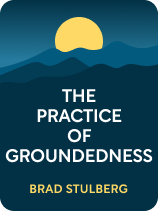

This article is an excerpt from the Shortform book guide to "The Practice of Groundedness" by Brad Stulberg. Shortform has the world's best summaries and analyses of books you should be reading.
Like this article? Sign up for a free trial here.
Want to learn how to be present in the moment more? How can you focus your energy on the here and now?
When you live in the present moment, you’re able to experience life more richly. To achieve this, you should schedule time to focus on tasks, remove potential distractions, and decide which tasks aren’t worth your time at all.
Continue reading to learn how to live fully in the present and focus better.
Living Fully in the Present
One important element of groundedness is living fully in the present moment. This is when you give your undivided attention to what’s happening now instead of dwelling in the past, thinking about the future, or multitasking. Learning how to be present in the moment allows you to experience your life more richly and be more intentional with how you use your time and energy.
Obsessing over self-improvement makes it hard to live in the present: When you’re constantly analyzing the past, worrying about the future, or going through your to-do list in your head, you scatter yourself in too many directions instead of focusing on what matters to you.
(Shortform note: This principle of living fully in the present moment is similar to the concept of mindfulness. According to Buddhist monk Bhante Gunaratana in Mindfulness in Plain English, mindfulness is the key to finding long-lasting peace and satisfaction with your life. To practice mindfulness as he describes it, when you focus on the present, you also practice detachment: You observe things as they are without attaching concepts, ideas, or emotions to them. This is important because a major source of our unhappiness is our tendency to categorize experiences as good, bad, or neutral—something we may naturally do when we pursue self-improvement.)
Here are some ways to redirect your attention to the present:
Schedule Focus Time
In today’s digital age, it’s easy to get distracted, but it’s also impractical to forbid yourself from ever multitasking or checking your devices. Thus, you should schedule periods of time throughout your day to be fully present. By scheduling focus time, you can be more purposeful and focus on what’s important to you. When planning your day, set aside chunks of time to focus entirely on the task at hand—whether it’s a work project or quality time with family and friends.
You can help yourself focus by removing potential distractions in advance. Find places to put away devices and other things that might divert your attention from the task you want to focus on. Having distractions around will test your willpower and make it hard for you to focus.
Decide What You Shouldn’t Do
In addition to scheduling what you need to do, it’s equally important to make a list of what you should not do. To-do lists can actually be counterproductive by making you feel obligated to perform useless tasks. To be more intentional with your time, reflect on what you spend your time on and cut any task that doesn’t align with your goals and values. This way, you can dedicate your full attention and energy to what matters.
| Additional Tips for Managing Your Focus and Attention In Hyperfocus, Chris Bailey agrees on the importance of focus and provides additional tips for scheduling focus time, eliminating distractions, and managing your tasks: Scheduling focus time: In addition to making time to focus, Bailey suggests you strategically decide when to focus. Schedule focus sessions for when you have the most energy (which you can determine by recording your energy levels for a few weeks). If needed, you can use caffeine to increase your focus just before starting your task or activity. Eliminating distractions: Bailey argues that we’re biologically driven to distraction, which is why it’s important to preempt distractions. We have a “novelty bias,” which means we get drawn to new things. On the neurochemical level, our brains release dopamine (a feel-good chemical) wherever we pivot to a new task or distraction. This motivates us to continue multitasking or giving in to distractions. To manage distractions, Bailey advises closing your email client, deleting or blocking access to apps, and disabling notifications. Deciding the tasks you shouldn’t do: Bailey suggests you decide which tasks to cut by reflecting first on the different tasks you currently spend your time doing. Create an attention matrix by sorting your tasks into four categories: unnecessary, distracting, necessary, and meaningful. This will help you realize how much time you spend on autopilot (wasting time on unnecessary or distracting tasks) and also identify what tasks to cut. |

———End of Preview———
Like what you just read? Read the rest of the world's best book summary and analysis of Brad Stulberg's "The Practice of Groundedness" at Shortform.
Here's what you'll find in our full The Practice of Groundedness summary:
- How "hustle" culture leads to burnout, illness, and unhappiness
- The six principles of groundedness to keep you balanced and stable
- Why you should create deep, quality relationships rather than many shallow ones






